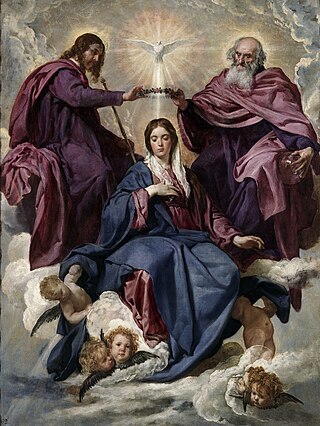
Queen of Heaven is a title given to the Virgin Mary, by Christians mainly of the Catholic Church and, to a lesser extent, in Anglicanism, Lutheranism, and Eastern Orthodoxy.

The following are Roman Catholic prayers to Saint Joseph.

Catholic Mariology is Mariology in Catholic theology. According to the Immaculate Conception taught by the Catholic Church, she was conceived and born without sin, hence Mary is seen as having a singular dignity above the saints, receiving a higher level of veneration than all angelic spirits and blessed souls in heaven. Catholic Mariology thus studies not only her life but also the veneration of her in daily life, prayer, hymns, art, music, and architecture in modern and ancient Christianity throughout the ages.
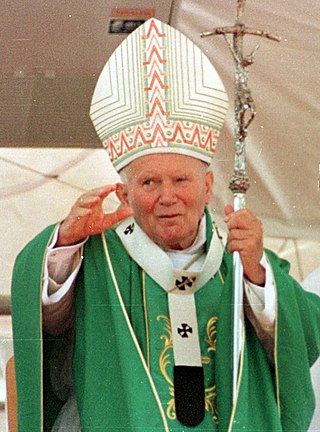
The teachings of Pope John Paul II are contained in a number of documents. It has been said that these teachings will have a long-lasting influence on the Church.
Ut unum sint is an encyclical by Pope John Paul II of 25 May 1995. It was one of 14 encyclicals issued by John Paul II. Cardinal Georges Cottier, Theologian emeritus of the Pontifical Household, was influential in drafting the encyclical.
Haurietis aquas is a landmark encyclical of Pope Pius XII on devotion to the Sacred Heart of Jesus. Written on May 15, 1956, it was attached to the 100th anniversary of the establishment of the feast of the Sacred Heart of Jesus by Pope Pius IX.
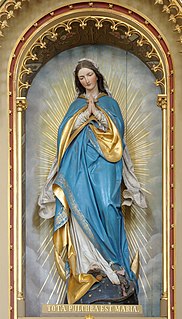
True Devotion to Mary is a book by Saint Louis de Montfort on the Roman Catholic theme of devotion to the Blessed Virgin Mary.

Mediatrix is a title given to Mary, mother of Jesus in Christianity. It refers to the intercessory role of the Blessed Virgin Mary as a mediator in the salvific redemption by her son Jesus Christ and that he bestows graces through her. Mediatrix is an ancient title that has been used by many saints since at least the 5th century. Its use grew during the Middle Ages and reached its height in the writings of saints Louis de Montfort and Alphonsus Liguori in the 18th century.

Redemptoris Mater is an encyclical by Pope John Paul II delivered on March 25, 1987 in Saint Peter's Basilica in Rome. Subtitled On the Blessed Virgin Mary in the life of the Pilgrim Church, the text addresses a number of topics in Mariology.

Marialis Cultus is the title of a Mariological apostolic exhortation by Pope Paul VI issued on February 2, 1974. It is subtitled: "For the Right Ordering and Development of Devotion to the Blessed Virgin Mary", and focuses Marian devotions, clarifying the way in which the Roman Catholic Church celebrates and commemorates Mary, the mother of Jesus. The exhortation sought to integrate devotion to Mary into the pastoral catechetical process, especially in liturgical catechesis, in a manner harmonious with the reforms of Vatican II. Mary must always be understood in relation to Jesus. The preparation of the document reportedly took 4 years.

The history of Catholic Mariology traces theological developments and views regarding Mary from the early Church to the 21st century. Mariology is a mainly Catholic ecclesiological study within theology, which centers on the relation of Mary, the Mother of God, and the Church. Theologically, it not only deals with her life but with her veneration in life and prayer, in art, music, and architecture, from ancient Christianity to modern times.

The Mariology of the popes is the theological study of the influence that the popes have had on the development, formulation and transformation of the Roman Catholic Church's doctrines and devotions relating to the Blessed Virgin Mary.
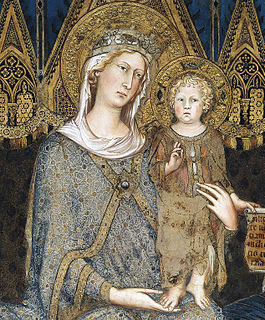
The veneration of Mary, mother of Jesus, in the Catholic Church encompasses various devotions which include prayer, pious acts, visual arts, poetry, and music devoted to the her. Popes have encouraged it, while also taking steps to reform some manifestations of it. The Holy See has insisted on the importance of distinguishing "true from false devotion, and authentic doctrine from its deformations by excess or defect". There are significantly more titles, feasts, and venerative Marian practices among Roman Catholics than in other Western Christian traditions. The term hyperdulia indicates the special veneration due to Mary, greater than the ordinary dulia for other saints, but utterly unlike the latria due only to God.
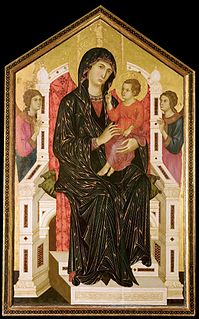
Mariological papal documents have been a major force that has shaped Roman Catholic Mariology over the centuries. Mariology is developed by theologians on the basis not only of Scripture and Tradition but also of the sensus fidei of the faithful as a whole, "from the bishops to the last of the faithful", and papal documents have recorded those developments, defining Marian dogmas, spreading doctrines and encouraging devotions within the Catholic Church.
Mother of the Church is a title given to Mary in the Roman Catholic Church, as officially declared by Pope Paul VI in 1964. The title first appeared in the 4th century writings of Saint Ambrose of Milan, as rediscovered by Hugo Rahner. It was also used by Pope Benedict XIV in 1748 and then by Pope Leo XIII in 1885. Pope John Paul II placed it in the Catechism of the Catholic Church and Pope Francis inserted a feast by this title into the Roman Calendar.
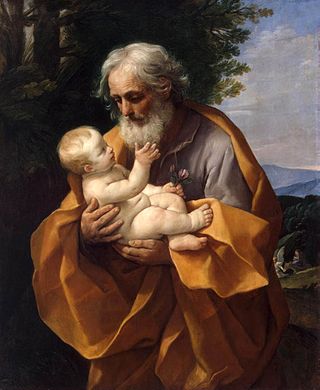
Joseph was a 1st-century Jewish man of Nazareth who, according to the canonical Gospels, was married to Mary, the mother of Jesus, and was the legal father of Jesus. The Gospels also name some brothers of Jesus who may have been: (1) the sons of Mary, the mother of Jesus, and Joseph; (2) sons of Mary, the wife of Clopas and sister of Mary the mother of Jesus; or (3) sons of Joseph by a former marriage.

The Pope John Paul II bibliography contains a list of works by Pope John Paul II, and works about his life and theology. Pope John Paul II reigned as pope of the Catholic Church and sovereign of Vatican City for 26 years and six months. Works written and published prior to his election to the papacy are attributed to Karol Wojtyła. Additional resources can be found on the Vatican website.
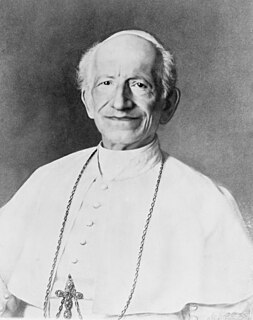
Quamquam pluries is an encyclical on Saint Joseph by Pope Leo XIII. It was issued on August 15, 1889 in Saint Peter's Basilica in Rome.
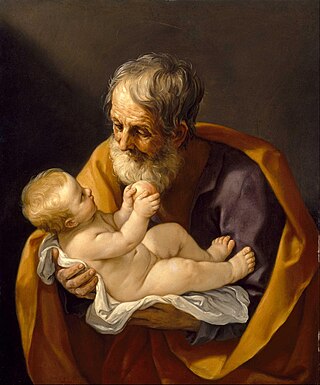
Josephology is the theological study of Joseph, the husband of Mary, mother of Jesus. Records of devotions to Joseph go back to the year 800 and Doctors of the Church since Thomas Aquinas have written on the subject. With the growth of Mariology, the theological study of Joseph also grew and in the 1950s specific centers for it were formed. The modern study of the theology concerning Joseph is one of the newest theological disciplines.
Tarcisio Stramare was an Italian priest, a biblical scholar, writer and teacher. He was considered one of the greatest international scholars of Josephology.
















